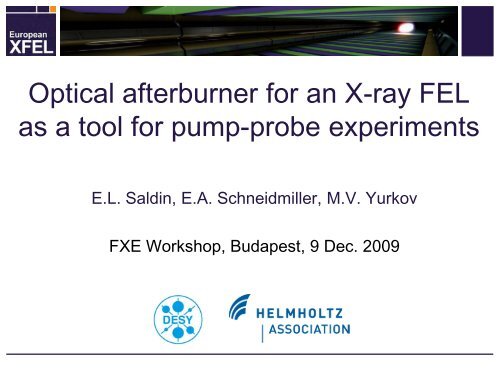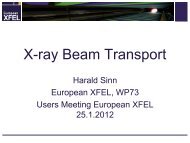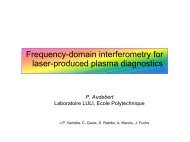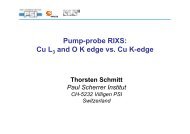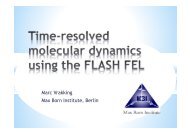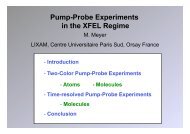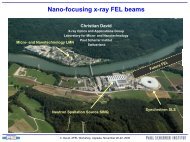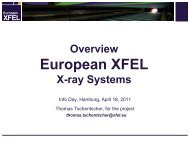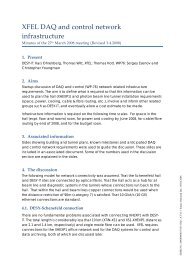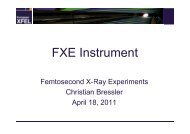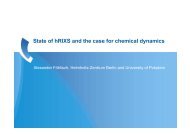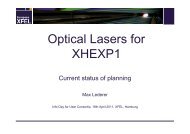Optical afterburner for an X-ray FEL as a tool for ... - European XFEL
Optical afterburner for an X-ray FEL as a tool for ... - European XFEL
Optical afterburner for an X-ray FEL as a tool for ... - European XFEL
Create successful ePaper yourself
Turn your PDF publications into a flip-book with our unique Google optimized e-Paper software.
<strong>Optical</strong> <strong>afterburner</strong> <strong>for</strong> <strong>an</strong> X-<strong>ray</strong> <strong>FEL</strong><br />
<strong>as</strong> a <strong>tool</strong> <strong>for</strong> pump-probe experiments<br />
E.L. Saldin, E.A. Schneidmiller, M.V. Yurkov<br />
FXE Workshop, Budapest, 9 Dec. 2009
FXE Workshop, Budapest, 9 Dec. 2009<br />
E.L. Saldin, E.A. Schneidmiller, M.V. Yurkov<br />
Contents of talk<br />
• Introduction<br />
• Developments at FLASH (soft X-<strong>ray</strong> <strong>FEL</strong> user facility)<br />
• Proposals <strong>for</strong> the Europe<strong>an</strong> X<strong>FEL</strong><br />
• Conclusions<br />
2
FXE Workshop, Budapest, 9 Dec. 2009<br />
E.L. Saldin, E.A. Schneidmiller, M.V. Yurkov<br />
Time resolution of a PP experiment<br />
Resolution is limited by:<br />
• Pulse duration of pump <strong>an</strong>d probe pulses<br />
• Time jitter between the two pulses<br />
3
FXE Workshop, Budapest, 9 Dec. 2009<br />
E.L. Saldin, E.A. Schneidmiller, M.V. Yurkov<br />
PP experiments with femtosecond<br />
resolution at X<strong>FEL</strong>s?<br />
• At FLASH 10 fs long (FWHM) soft X-<strong>ray</strong> pulses are routinely<br />
delivered to users (single-digit fs pulses c<strong>an</strong> be expected <strong>for</strong><br />
harmonics)<br />
• At LCLS low charge bunches (20 pC) are believed to produce<br />
single-digit fs pulses (hard <strong>an</strong>d soft X-<strong>ray</strong>s); first users already<br />
appreciate 20 pC option<br />
• Powerful femtosecond optical l<strong>as</strong>ers are available<br />
There is the solid b<strong>as</strong>e <strong>for</strong> PP experiments at X-<strong>ray</strong> <strong>FEL</strong>s with<br />
femtosecond resolution (few to 10 fs)<br />
4
FXE Workshop, Budapest, 9 Dec. 2009<br />
E.L. Saldin, E.A. Schneidmiller, M.V. Yurkov<br />
An obstacle: jitter of e-beam arrival time<br />
Main source of the jitter:<br />
• Energy-dependent path length in magnetic bunch<br />
compressors. Jitter of RF amplitude <strong>an</strong>d ph<strong>as</strong>e in accelerating<br />
modules tr<strong>an</strong>slates into arrival time jitter.<br />
Present status:<br />
• Typical jitter of radiation pulses from FLASH is about 0.5 ps<br />
(FWHM) when the beam is delivered to users<br />
• Jitter of e-beam in LCLS linac w<strong>as</strong> me<strong>as</strong>ured at about 100 fs<br />
(FWHM)<br />
A large gap (1-2 orders of magnitude) between pulse durations<br />
<strong>an</strong>d time jitters<br />
5
FXE Workshop, Budapest, 9 Dec. 2009<br />
E.L. Saldin, E.A. Schneidmiller, M.V. Yurkov<br />
Approaches to cope with jitter<br />
• Straight<strong>for</strong>ward: improve RF stability<br />
• More sophisticated:<br />
- global synchronization<br />
- electro-optical sampling (EOS)<br />
- beam arrival monitor (BAM)<br />
- beam-b<strong>as</strong>ed feedback<br />
- dedicated user setup: use known process<br />
…<br />
• Natural: produce two pulses of different colors (<strong>for</strong> inst<strong>an</strong>ce, x<strong>ray</strong><br />
<strong>an</strong>d optical pulses) by the same electron bunch.<br />
6
FXE Workshop, Budapest, 9 Dec. 2009<br />
E.L. Saldin, E.A. Schneidmiller, M.V. Yurkov<br />
Two-color operation of <strong>an</strong> X<strong>FEL</strong><br />
• Create e-beam density modulation (if it does not exist) in the<br />
desired wavelength r<strong>an</strong>ge<br />
• Use some radiator<br />
• Tr<strong>an</strong>sport optical beam to experiment <strong>an</strong>d<br />
- use directly (if intense enough)<br />
- amplify <strong>an</strong>d use<br />
- cross-correlate with a powerful PP l<strong>as</strong>er <strong>an</strong>d sort out the data<br />
7
FXE Workshop, Budapest, 9 Dec. 2009<br />
E.L. Saldin, E.A. Schneidmiller, M.V. Yurkov<br />
Proposal <strong>for</strong> PP experiments at FLASH (2001)<br />
FIR undulator <strong>an</strong>d THz beamline installed<br />
<strong>an</strong>d commissioned in 2007-2008<br />
(O.Grimm, M.Gensch et al.)<br />
8
FXE Workshop, Budapest, 9 Dec. 2009<br />
E.L. Saldin, E.A. Schneidmiller, M.V. Yurkov<br />
THz streak camera at FLASH (2008)<br />
Courtesy Ulrike Frühling<br />
FLASH: 13.5 nm<br />
FIR: 85 µm<br />
G<strong>as</strong>: Krypton (4p)<br />
Kinetische Energie [eV]<br />
1,5 2 2,5 3<br />
Zeit [ps]<br />
Two beams (FIR <strong>an</strong>d soft X-<strong>ray</strong>) were tr<strong>an</strong>sported about 100 m via<br />
separate beam lines <strong>an</strong>d combined in time <strong>an</strong>d space. Me<strong>as</strong>ured time<br />
jitter w<strong>as</strong> 5 fs rms (about 10 fs FWHM).<br />
95<br />
90<br />
85<br />
80<br />
75<br />
70<br />
65<br />
60<br />
0<br />
0,5<br />
1<br />
3,5<br />
4<br />
4,5<br />
5<br />
0.6<br />
0.5<br />
0.4<br />
0.3<br />
0.2<br />
0.1<br />
0<br />
9
Two-color (X-<strong>ray</strong>+optical) <strong>FEL</strong> proposal (2003)<br />
Proposal not accepted but …<br />
FXE Workshop, Budapest, 9 Dec. 2009<br />
E.L. Saldin, E.A. Schneidmiller, M.V. Yurkov<br />
Published in<br />
Nucl.Instr. & Meth. A528(2004)453<br />
10
FXE Workshop, Budapest, 9 Dec. 2009<br />
E.L. Saldin, E.A. Schneidmiller, M.V. Yurkov<br />
Proof-of-principle experiment at FLASH (2009)<br />
• ORFIR collaboration (M. Gensch et al.) combined two independent<br />
projects: <strong>Optical</strong> Replica Synthesizer (ORS) <strong>an</strong>d Far-Infrared Undulator<br />
• <strong>Optical</strong> Replica Synthesizer (Saldin et al.) is a device <strong>for</strong> diagnostics of<br />
ultra-short electron bunches. It w<strong>as</strong> successfully comissioned this year<br />
(V. Ziem<strong>an</strong>n et al.). It consists of a l<strong>as</strong>er, two undulators, <strong>an</strong>d a<br />
dispersion section (plus diagnostics). During the experiment the second<br />
undulator w<strong>as</strong> off.<br />
• Far-Infrared Undulator w<strong>as</strong> tuned to l<strong>as</strong>er wavelength, 770 nm<br />
• Strong coherent radiation from FIR undulator w<strong>as</strong> detected: 1 µJ within a<br />
narrow b<strong>an</strong>d<br />
• SASE <strong>FEL</strong> operation w<strong>as</strong> not disturbed<br />
FLASH e-logbook, 20.03.09:<br />
Summary from <strong>FEL</strong> users: we saw 1 micro Joule of 770 nm radiation in the THz beamline!<br />
11
FXE Workshop, Budapest, 9 Dec. 2009<br />
E.L. Saldin, E.A. Schneidmiller, M.V. Yurkov<br />
Another experiment at FLASH (2009)<br />
N.Stoj<strong>an</strong>ovic, F.Tavella, G.Geloni, M.Gensch, to be published<br />
• Coherent THz radiation is produced in FIR undulator by a short<br />
electron bunch<br />
• Alternatively, coherent edge radiation (THz) is produced by a short<br />
electron bunch behind SASE undulator (FIR undulator off)<br />
• Radiation is tr<strong>an</strong>sported down the THz beamline <strong>an</strong>d cross-corelated<br />
with high-power PP l<strong>as</strong>er<br />
• Timing accuracy better th<strong>an</strong> 5 fs rms is achieved (about10 fs FWHM)<br />
12
FXE Workshop, Budapest, 9 Dec. 2009<br />
E.L. Saldin, E.A. Schneidmiller, M.V. Yurkov<br />
FLASH paves the way <strong>for</strong> the Europe<strong>an</strong> X<strong>FEL</strong><br />
Concluding studies at FLASH: all b<strong>as</strong>ic ide<strong>as</strong> of the method<br />
(one bunch – two colors <strong>for</strong> PP) were successfully tested.<br />
PP experiments with 10 fs resolution (or better?) are possible at<br />
FLASH.<br />
It is e<strong>as</strong>ier now to make decisions <strong>for</strong> big machines like the<br />
Europe<strong>an</strong> X<strong>FEL</strong>.<br />
13
FXE Workshop, Budapest, 9 Dec. 2009<br />
E.L. Saldin, E.A. Schneidmiller, M.V. Yurkov<br />
Existing proposal <strong>for</strong> the Europe<strong>an</strong> X<strong>FEL</strong><br />
G.Geloni et al., Opt. Commun. 281(2008)3762<br />
• Use <strong>Optical</strong> Replica Synthesizer (ORS)* to modulate the beam (400 nm)<br />
• Coherent edge radiation (about 1012 photons) is produced behind X<strong>FEL</strong><br />
undulator<br />
• Tr<strong>an</strong>sport the optical beam to experimental hall <strong>an</strong>d do cross-correlation<br />
with a high-power l<strong>as</strong>er<br />
• All these ide<strong>as</strong> were tested at FLASH!<br />
*Decision on ORS <strong>for</strong> Europe<strong>an</strong> X<strong>FEL</strong> still to be made<br />
14
FXE Workshop, Budapest, 9 Dec. 2009<br />
E.L. Saldin, E.A. Schneidmiller, M.V. Yurkov<br />
Recent idea: optical <strong>afterburner</strong> <strong>for</strong> SASE<br />
• Very simple scheme, does not require external l<strong>as</strong>ers etc.<br />
• Uses intrinsic features of SASE process<br />
SSY, submitted to Phys. Rev. ST-AB<br />
15
FXE Workshop, Budapest, 9 Dec. 2009<br />
E.L. Saldin, E.A. Schneidmiller, M.V. Yurkov<br />
How it works<br />
SASE1 power at saturation:<br />
typical feature size is 0.3 fs (100 nm)<br />
• <strong>Optical</strong> frequencies appear in electron beam ph<strong>as</strong>e space (time-energy) due<br />
to nonlinearities of the SASE <strong>FEL</strong> process<br />
• These frequencies appear in energy modulations but not in density<br />
modulations<br />
• Install a compact dispersion section (4-bend chic<strong>an</strong>e) that converts energy<br />
modulations into density modulations<br />
• Longitudinal dispersion is characterized by R56 element:<br />
∆s = R56 ∆Ε/Ε0 SSY, submitted to Phys. Rev. ST-AB<br />
16
FXE Workshop, Budapest, 9 Dec. 2009<br />
E.L. Saldin, E.A. Schneidmiller, M.V. Yurkov<br />
Modulations behind SASE1<br />
TDR c<strong>as</strong>e:<br />
1 nC, ε n = 1.4 mm*mrad<br />
SSY, submitted to Phys. Rev. ST-AB<br />
Low emitt<strong>an</strong>ce c<strong>as</strong>e:<br />
200 pC, ε n = 0.4 mm*mrad<br />
R 56= 50 µm R 56= 10 µm<br />
17
FXE Workshop, Budapest, 9 Dec. 2009<br />
E.L. Saldin, E.A. Schneidmiller, M.V. Yurkov<br />
Modulations behind SASE1: TDR c<strong>as</strong>e<br />
R 56= 50 µm R 56= 200 µm R 56= 500 µm<br />
One c<strong>an</strong> control modulation scale by ch<strong>an</strong>ging R 56<br />
18<br />
SSY, submitted to Phys. Rev. ST-AB
FXE Workshop, Budapest, 9 Dec. 2009<br />
E.L. Saldin, E.A. Schneidmiller, M.V. Yurkov<br />
Averaged bunch <strong>for</strong>m-factor: TDR c<strong>as</strong>e<br />
Solid: R 56= 50 µm, dot: R56= 200 µm, d<strong>as</strong>h: R56= 500 µm<br />
19<br />
SSY, submitted to Phys. Rev. ST-AB
FXE Workshop, Budapest, 9 Dec. 2009<br />
E.L. Saldin, E.A. Schneidmiller, M.V. Yurkov<br />
Undulator radiation: TDR c<strong>as</strong>e<br />
Solid: R 56= 50 µm, dot: R56= 200 µm, d<strong>as</strong>h: R56= 500 µm<br />
within coherent <strong>an</strong>gle, 10% BW<br />
pulse energy fluctuations below 10%<br />
Undulator is similar to that installed in FLASH:<br />
10 periods,<br />
period length 70 cm,<br />
maximum field 1.2 T<br />
20<br />
SSY, submitted to Phys. Rev. ST-AB
Adv<strong>an</strong>tages:<br />
FXE Workshop, Budapest, 9 Dec. 2009<br />
E.L. Saldin, E.A. Schneidmiller, M.V. Yurkov<br />
Chaotic versus periodic modulations<br />
• Cheap <strong>an</strong>d robust method<br />
• Pulse width the same <strong>as</strong> that of SASE pulse, perfect timing<br />
down to sub-fs <strong>for</strong> hard x-<strong>ray</strong>s<br />
• Wider spectral r<strong>an</strong>ge available<br />
• On-line monitoring of SASE pulse width possible<br />
Disadv<strong>an</strong>tages:<br />
• Less power (in c<strong>as</strong>e of undulator)<br />
• Intrinsic shot-to-shot fluctuations of pulse energy<br />
21
FXE Workshop, Budapest, 9 Dec. 2009<br />
E.L. Saldin, E.A. Schneidmiller, M.V. Yurkov<br />
Undulator versus edge radiation<br />
• For chaotic modulations: comparable power (pulse energy),<br />
but spectral brightness higher by number of periods<br />
• For periodic modulations the power (<strong>an</strong>d pulse energy)<br />
incre<strong>as</strong>es linearly with number of periods. For reference:<br />
10% density modulation at 400 nm would result in 25 uJ <strong>for</strong><br />
considered bunch <strong>an</strong>d undulator<br />
• Und. radiation is e<strong>as</strong>ier to h<strong>an</strong>dle (edge radiation is radially<br />
polarized, h<strong>as</strong> rings in <strong>an</strong>gular distribution)<br />
• Divergence is larger <strong>for</strong> undulator radiation: 200 microradi<strong>an</strong><br />
(at 400 nm) versus 50 microradi<strong>an</strong><br />
22
FXE Workshop, Budapest, 9 Dec. 2009<br />
E.L. Saldin, E.A. Schneidmiller, M.V. Yurkov<br />
On-line monitoring of X-<strong>ray</strong> pulse duration<br />
• “Visualization” of X-<strong>ray</strong> pulse, i.e. tr<strong>an</strong>slating its width <strong>an</strong>d shape<br />
into optical r<strong>an</strong>ge (making “optical replica”)<br />
• On-line me<strong>as</strong>urement with FROG or its relatives<br />
• Radiator:<br />
• Me<strong>as</strong>ure ensemble-average envelope (adjacent averaging<br />
possible)<br />
• Works well <strong>for</strong> linear regime, some broadening at saturation<br />
23<br />
SSY, submitted to Phys. Rev. ST-AB
FXE Workshop, Budapest, 9 Dec. 2009<br />
E.L. Saldin, E.A. Schneidmiller, M.V. Yurkov<br />
On-line monitoring of X-<strong>ray</strong> pulse duration<br />
Simulation of single shot reconstruction: SASE1 at saturation.<br />
single shot<br />
red: ensemble average <strong>FEL</strong> power<br />
blue: reconstruction (adjacent averaging used)<br />
24<br />
SSY, submitted to Phys. Rev. ST-AB
FXE Workshop, Budapest, 9 Dec. 2009<br />
E.L. Saldin, E.A. Schneidmiller, M.V. Yurkov<br />
Conclusions<br />
• Two-color schemes resolve jitter issue: proven at FLASH<br />
• For Europe<strong>an</strong> X<strong>FEL</strong> two scenarios are proposed, c<strong>an</strong> be<br />
realized simult<strong>an</strong>eously<br />
• <strong>Optical</strong> Replica Synthesizer would be very useful<br />
• Minimal extension of X<strong>FEL</strong>: compact dispersion section<br />
behind SASE undulator (use edge radiation)<br />
• Next step: install undulator reson<strong>an</strong>t to optical frequencies<br />
• Robust on-line monitoring of SASE pulse duration is<br />
possible<br />
• Similar <strong>afterburner</strong>s c<strong>an</strong> be installed behind SASE2 <strong>an</strong>d<br />
SASE3<br />
25


